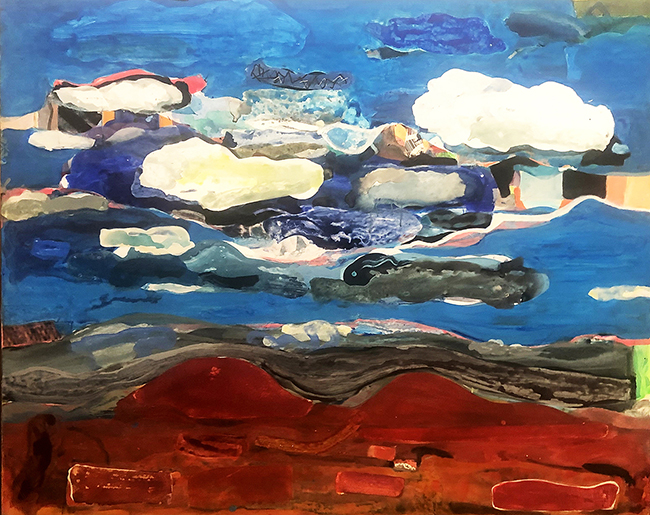Mitchell Rosenzweig is an experienced artist whose abstract mixed media paintings don’t demand attention—they earn it. At first glance, they might seem spontaneous, but there’s a solid framework beneath the surface. Layers of paint, scraps of paper, and other materials settle into place like sediment, forming a thick, deliberate build. It’s not random piling. It’s structure with purpose. A kind of visual scaffolding that quietly supports everything you see.

What sets Rosenzweig’s work apart is how he brings two seemingly opposite forces together—chaos and control. A lot of artists work with layers, especially in abstract mixed media. But Rosenzweig’s layering doesn’t just build texture or evoke movement. It carries weight. The details hold each other up. The surface, no matter how active, never feels fragile. That’s rare.
Take Desert Clouds for example, one of his more landscape-inspired paintings. He started this one years ago in New Mexico, where he spent time watching the sky, absorbing the intense desert light and color. Unlike many of his more abstract works, Desert Clouds leans into some representational detail—specifically, the clouds that drift across the top. Still, it’s not a literal landscape. It’s filtered through memory and material. He worked on it for a long time, repainting it multiple times over the years. When the process stalled, he let it rest. Then he came back. Again and again, until it was done.
This slow process isn’t a gimmick or some kind of dramatic gesture. It’s just how Rosenzweig works. He builds his surfaces the way nature builds terrain—layering, compacting, letting things settle, returning with more. It’s a rhythm that feels both personal and geological. You get the sense he’s not just making images but trying to capture time, erosion, presence.
There’s also something tactile about his paintings. You don’t just see them. You want to get up close and trace the edge of a scrap of paper or a smudge of pigment. The materials aren’t hidden or smoothed away. They’re part of the language. That said, these works don’t feel messy. The density is never overwhelming. He knows where to stop. Or at least when to pause long enough to let the surface breathe.
Rosenzweig’s landscapes aren’t always recognizable. Often, they’re completely abstract. But there’s a strong sense of place in everything he does. Even if you don’t see mountains or trees, you feel the weight of terrain. You feel the atmosphere. That might be why people respond so viscerally to his paintings. There’s something familiar under all the abstraction—like walking through a dream of a place you once knew.
His time in New Mexico clearly left an imprint. The desert appears often, not always in form, but in energy. It’s that sharp contrast between openness and density, between the vast sky and the parched earth. His colors shift with similar contrast. You’ll find dusty neutrals against hot oranges, pale blues layered with rusted reds. Nothing is flat. Everything feels weathered, but still alive.
Rosenzweig doesn’t just paint the landscape. He excavates it. And that goes for his process too. Each painting is a kind of dig site—material unearthed, arranged, reconsidered. Sometimes he puts a work away for years before returning to it with new eyes. He seems comfortable with that kind of distance. He lets time do its work.
That patience, that willingness to sit with the unfinished, is part of what gives his paintings their strange gravity. They hold tension. They carry memory. And they invite you to stay a while, to sift through their surfaces like you’re searching for something—maybe something you lost or something you didn’t know you were looking for.
Rosenzweig’s work isn’t loud. It doesn’t tell you what to feel. But it stays with you. Like the way light settles over the desert before dusk. Or how a half-buried object can suddenly catch your eye.
There’s strength in that kind of stillness. And in the quiet accumulation of time.

